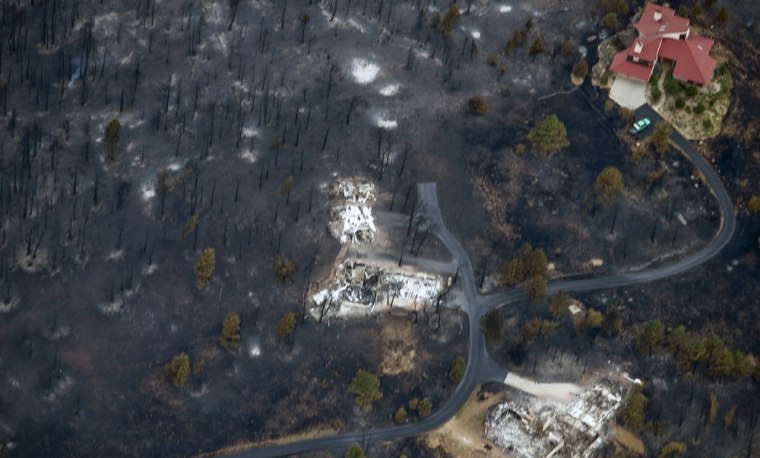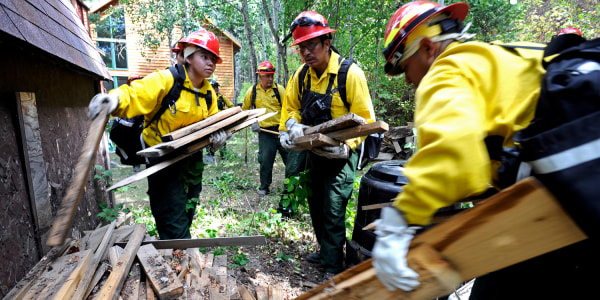A Colorado wildfire that already burned about 170 homes showed no signs of relenting Thursday night as 60 mph wind gusts threatened to drive flames into the heart of Boulder.
Authorities told residents on Boulder's west side prepare to evacuate if the wildfire moves into town. They urged people to remove lawn furniture, brush and propane tanks that could fuel the fire. The city is also mowing grass in open spaces to cut down on potential fuel, and telling residents to do the same.
The city encouraged residents to gas up and park their cars pointed toward the road for a speedy getaway, wet down yards and vegetation and pack up important documents, medication and other items in case they have to flee.
Wind gusts could blow away the little moisture the area has seen and spread the fire beyond the 20-mile-long perimeter that has the blaze 30 percent contained.
"The wind event tonight, we could be off to the races," said Rob Bozeman, field observer with the Boulder Mountain Fire Protection District.
Neighborhoods once filled with million-dollar homes and scenic mountain cabins have become piles of smoking rubble. On one lot, all that survived was a tennis court. On others, all that's left are crumbling, ash-covered foundations.
Boulder, a city of about 100,000, is home to the University of Colorado and the National Institute of Standards and Technology, a federal laboratory best known for running the atomic clock that's used to maintain the official U.S. time. Employees there were allowed to leave work if they needed to go home to prepare of a possible evacuation, said spokesman James Burrus.
Authorities said the biggest fire danger was on the northern portion of Broadway, one of Boulder's main thoroughfares. The federal lab is on Broadway farther south, and the edge of the campus is on the eastern side. Many sorority and fraternity houses are on the western side of the road.
Slideshow 14 photos
Colorado battles destructive wildfire
"This is absolutely a precaution. But it's an active fire. High winds are expected," said emergency management team spokesman Dan Rowland.
This isn't the first time that Boulder has faced a wildfire threat. The city has mountain parks and abundant public open space considered potential trouble spots when fires have started in the mountains. A January 2009 wildfire crept up to Boulder's northern outer edges, but the city escaped unscathed.
On Thursday evening Joe Glynn was hosing down his yard in northwest Boulder and his 9-year-old son, Daniel, sprayed water on city open space next to their lot. His family was packing bags and taking other steps in case they have to flee, but Glynn — who has witnessed two other wildfires — said he will stay behind and protect his home of 19 years.
"I'm going to stand on the roof with a hose if necessary," he said.
The preparations in Boulder reflect the ferocity of the wildfire since it broke out Monday and spread over a 10-square-mile area. It has since become one of the most destructive fires in Colorado, destroying more homes than any other blaze in state history.
The blaze has scorched about more than 6,300 acres, or roughly 10 square miles.
Fire officials said the Fourmile Fire, as its known locally, could take 10 days or more to contain , and has already cost $2.1 million just to fight.
Despite the progress, firefighters "are dealing with a very large, very chaotic and very unpredictable situation," quoted Boulder County Sheriff Joe Pelle as saying.
About 3,500 people have been out of their homes for four days, and some residents have been frustrated with a lack of information about what was happening behind fire lines because they couldn't do more to help. Some have gotten around roadblocks by hiking and biking in to check on their homes, and an unknown number of people who got back into homes decided to stay and hunker down.
An unknown number of people who were temporarily allowed back to their homes Thursday before winds picked up decided to hunker down and stay.
Lee McCormack, referring to the area behind a ridge.
Authorities are investigating whether a vehicle crashing into a propane tank started the fire. A recording of a 911 call and other communications released by the sheriff's office chronicles reports of flames after the collision jumping to trees in the fire area.
In steep canyons about five miles west of Boulder, firefighters were trying to secure fire lines. But the powerful wind gusts in the forecast could spread the fire beyond the 20-mile-long perimeter.
Winslow Robertson, the operations chief for the fire, estimated firefighters have been able to contain 45 percent of the blaze. He said no more structures were lost Thursday.
Houses in the area range from million-dollar sprawling homes with tennis courts and swimming pools to more modest ranch-style homes with wooden decks, some of which survived another fire in 1989. Homes are nestled on ridges and steep mountains, with winding roads leading to some of the homes.
All seem to share a love of the outdoors, with several willing to hike or mountain bike miles past road blocks to check on their homes. Others stayed behind to fight the fire on their own, including one man who used his tractor to scoop up flames and save the children's summer camp his family operates.
The area also includes the historic town of Gold Hill, home to an Old West grocery store and structures once used for stagecoach stops. Crews managed to spare it from the fire.
Nine people had been reported missing in the fire zone but sheriff's Cmdr. Rick Brough said they all have been accounted for.
The reported loss of homes surpasses that of the 2002 Hayman fire in southern Colorado that was the most destructive in the state's history. That fire destroyed 133 homes and 466 outbuildings on 138,000 acres of more sparsely populated area that includes national forest land.
Fire managers said as many 700 firefighters and support personnel and seven air tankers were assigned to fight the fire, considered the nation's top firefighting priority.
It's a busy end to a relatively quiet fire season. Nationwide, about 2.6 million acres have burned this summer, about 50 percent less than the 10 year average, said Ken Frederick, spokesman for the National Interagency Fire Center in Boise, Idaho.

